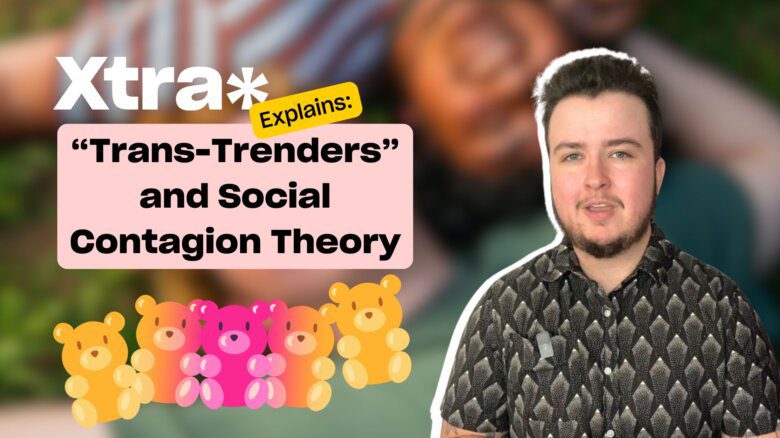It feels like we say this every year, but in 2024, trans people are more visible than ever.
That is both a fact worth celebrating, and one with weighty implications as our visibility continues to be weaponized by the political right. We’re in more movies and TV shows, yes. But our identities and basic rights are also on the lips of many of the most influential conservative politicians and voices across Canada as they seek to roll back our fundamental rights.
There is undeniable triumph in trans visibility, particularly its increase over the past decade. Ask any trans person, myself included, and we’ll likely cite some version of visible possibility models who paved the way for our named existence. That first time we heard the word “transgender,” or learned that a person could have surgery or take hormones to make our body feel the way it should. There’s the first person we saw on TV, or the person with a they/them pin we saw on the street who gave us that Alison Bechdel-esque “ring of keys” moment. That’s all visibility.
And the current state of trans visibility is a far cry from decades past, where trans people certainly existed, but were not nearly as visible to the general public. Vital information-sharing on trans possibilities was done in more underground, word-of-mouth ways, passed between closet doors and within community. Now, we have vocal trans activists like Fae Johnstone appearing on the CBC, influencers like Dylan Mulvaney documenting their transitions on TikTok and Oscar nominees speaking casually about using she/they pronouns. Heck, you can even buy binders at Target now! And Google searches for phrases like “pronouns,” “gender” and “non-binary” have increased over the past decade: a sign of how these concepts are increasingly part of everyday vernacular.
March 31 is International Transgender Day of Visibility, an occasion first marked 15 years ago to celebrate trans people and raise awareness of the discrimination we face. It’s usually brighter in tone than our other major annual occasion—Trans Day of Remembrance in November, which marks the lives lost to anti-trans violence every year.
And that levity is, on one level, refreshing amidst all of the garbage trans people must deal with. Check the #transdayofvisibility hashtag on social media and you’ll see plenty of trans people revelling in pure trans joy, proudly showing off top surgery scars, pronoun pins and transition timeline photos. And that’s great! More visible trans people—and more visible trans people who aren’t reduced to headlines about murder or hate crimes—means more people exposed to our lives and our stories and our realities. And joy is good!
That visibility means not only more people coming into their transness after seeing transness in the world, it also means (hopefully) more empathy and understanding from society at large. Visibility is something to celebrate—that’s what Trans Day of Visibility is about at its core. But this year, more than ever, I’m conscious of another, more insidious visibility that has unfortunately become a pervasive part of trans peoples’ lives: our visibility as a weapon and threat in the eyes of the conservative right.
There’s obviously been a series of legislative and ideological attacks on trans rights occuring in the United States and United Kingdom in recent years. But even in Canada—over the past year especially—trans people have increasingly become a political flashpoint for right-wing politicians and movements. Our lives have been used as fodder for debate and policy platforms from people leading governments or hoping to step into power. In New Brunswick, Alberta and Saskatchewan, trans rights have entered the political debate sphere with policies and legislation taking aim at gender-affirming care, pronouns and sex-ed in schools under the guise of “parental rights.” And across the country, discord is being sewn at the school board and municipal levels.
And amidst the pre-campaign of our next federal election, Conservative Party of Canada leader (and likely next prime minister, if polls are to be believed) Pierre Poilievre has planted his flag in the anti-trans camp, echoing talking points against puberty blockers for minors and referring to trans women as “biological males.”
These moves and stances are not only deeply anti-science, but they also take advantage of the positive boom in trans visibility over the past decade, and weaponize it to attack the fundamental rights of a vulnerable portion of this country’s population. As trans people—and frankly anyone who dares to challenge binaries or “traditional families”—have become more visible, the attacks on our fundamental rights have escalated and intensified. It often feels like two steps backward for every step of progress we gain.
I was thinking about this recently as I dove into Judith Butler’s new book, Who’s Afraid of Gender? In it, the gender theory pioneer argues that the current attack on “gender” is a spiralling escalation spurred by right-wing media catastrophizing what traditional aspects of society “gender”—i.e., trans and non-binary people—threaten.
“When gender is figured as a threat to humanity, civilization, ‘man’ and nature, when gender is likened to a nuclear catastrophe, the Ebola virus, or full-blown demonic power, then it is this escalating fear of destruction to which political actors appeal,” Butler writes. “They see the escalating fear and know that they can make use of it for their own purposes, so they escalate it even more.”
Who’s Afraid of Gender? is a decidedly less academic work than usual from the notoriously convoluted Butler. And that’s very much needed, as Butler methodically dispels many key anti-trans talking points and arguments in ways that may actually influence someone who’s innocently fallen prey to anti-trans arguments (though only if those people are brave enough to pick up a book with the non-binary flag on its cover).
At the book’s foundation, though, Butler argues that the threat trans people pose to conservatives is how we challenge the [supposed?] “inevitability and superiority of the heteronormative family form.”
“Self-assignment is a form of freedom to live a livable life, a collective freedom that has been achieved through struggle. It is, however, twisted into a rights-stripping activity in order to justify stripping trans people of their rights,” Butler writes. “Similarly, queer families do not negate heterosexual ones. They only dispute the inevitability and superiority of the heteronormative family form.”
Anti-trans actors are afraid of trans people, and use us and our visibility as political cudgels, because we posit possibilities beyond the world they’ve built. Many smart people, Butler included, have rightfully pointed out how this is all rooted in racism and sexism—if conceptions of “womanhood” and “manhood” are malleable and subject to the self-determination trans people represent, then how could a society where women are lesser and capitalism rules even exist?
As we’re seeing in Canadian politics right now, conservatives then use these threats to prey on voters and audiences’ insecurities around those societal rules and weasel their way into power to continue enacting and upholding that sexist, racist, capitalist society.
It’s justified for these right-wing politicians to see trans people as a threat to those institutions. They should! Being trans, and specifically being visibly trans, isn’t just about hormones and pronouns and top surgery scars. It’s fundamentally about challenging existing structures of society. These structures extend beyond simple definitions of man and women and into territory like healthcare access, self-determination and family structures.
There is this fear of trans visibility because, to the anti-trans, it serves as a form of indoctrination, particularly for kids. Book bans, attacks on gender-affirming care for minors and changes to sex-ed curriculum all come from the same place: a resistance to young people being exposed to queerness or transness, lest they see themselves reflected in them and decide that they themselves are queer or trans. Politicians can dance around it with soft-spoken messages and claims about protecting kids and the rights of trans adults, but at their very root these policies are grounded in the idea of preventing trans kids from claiming transness, and the challenges to our bigger institutions that come with that.
For the same reasons that trans people and our allies celebrate trans visibility and its ability to give a questioning person that “ring of keys moment,” so too do anti-trans actors fear it for awakening another person who questions or challenges the traditional heteronormative, sexist, racist version of capitalism we live in.
“[Conservatives] warn against ‘recruiting’ by gay and lesbian teachers or books, but they are recruiting the public into a phantasmatic scene in which they are the ones who are being stripped of a sexed identity by progressive laws,” Butler argues.
Just look at the 1 Million March for Children in Canada last fall. A wide range of people, including parents motivated by religious concern, stated transphobes, white nationalists and genuinely concerned centrists across the country, participated in the event under the guise of protecting “parental rights.” They were fed messages about the spectre of hasty medical procedures and social contagion and misinformation about trans people and sexual orientation and gender identity (SOGI) policies in schools.
Like a Scooby-Doo villain, take off that “concerned parents” rubber mask and the parental rights movement is rooted in the same anti-trans ideology as Alberta premier Danielle Smith wanting to ban trans women from sports.
To be clear, in 2024, trans visibility matters. But it matters beyond simply seeing someone in a movie and saying “that’s like me!” or an influencer sharing their HRT journey. Trans visibility in the current moment is about owning our self-determination and the power it can wield. It’s about reclaiming our visibility, and not letting it be used against us by these bad actors. It’s taking what they’re afraid of—that transness is a threat to so-called “traditional” values—and embracing and celebrating that.
On this International Transgender Day of Visibility, I celebrate the bravery and visibility of my trans siblings. I celebrate my own personal visibility, even with the abuse or threats or complications it can often bring (though I’ve learned to just not look at my Twitter mentions). And I call on all of us to maintain that visibility that these politicians seem so threatened by, even as it continues to be weaponized against us.
Sometimes it can feel like retreating into respectability politics is the answer—to be quiet, to hide our transness out of self-preservation and to not push for that loud visibility into the spaces where it can be used against us. And I get it, particularly as individual visibility can feel scary in this moment.
But as Butler argues at the end of Who’s Afraid of Gender?, our collective visibility is powerful.
“The only way out of this bind is to ally the struggle for gender freedoms and rights with the critique of capitalism, to formulate the freedoms for which we struggle as collective ones and to let gender become part of a broader struggle for a social and economic world that eliminates precarity and provides healthcare, shelter and food across all regions.”


 Why you can trust Xtra
Why you can trust Xtra


